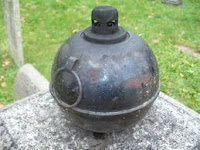So we are beating Mother Nature to the punch once again and filling it ourselves. We are sowing orchard grass, diakon radish, and clover seed on our orchard tiers. If we don't seed it Mother Nature will with assorted weeds that we don't want plants there. That doesn't mean birds and wind won't carry seeds into this area. We do expect some especially since we only manages to cardboard and deep mulch one tier before the cold weather set in last year. We started this process way too late.
 The number one reason for seeding the area late last fall was plant life helps stop erosion of the topsoil.We knew the winter rains run off would erode the tiers. Since the seeds we sowed did not get a chance to go to seed before the snows and freezes killed it off, we are resowing them this spring.
The number one reason for seeding the area late last fall was plant life helps stop erosion of the topsoil.We knew the winter rains run off would erode the tiers. Since the seeds we sowed did not get a chance to go to seed before the snows and freezes killed it off, we are resowing them this spring.History showed us what can happen when soil erosion takes place. Especially, when man is involved. Remember reading about the Great Dust Bowl of the 1930s? My grandmother and father lived in Nebraska during it and it's in her journal. Yes, the cause was partially man made. It caused by the stripping away of large hectares of deep rooted grasses to plant crops by homesteaders in a five state area. Except one man made factor
coupled with one Mother Nature factor were working against them. The Great Depression and a drought. The farmers couldn't plant and sell their crops so they didn't plant. With no cover crop, the top soil blew off in wind storms. Now I'm not saying that my 1/4 acre bare spot of an orchard would cause a dust bowl situation, but erosion of top soil is never a good thing. So even though we knew whatever cover crop we planted wouldn't reach maturity, we sowed a crop last fall figuring it would help fight erosion and regrowth of other things we didn't want in this area.
We are still nine months to a year away from totally planting all the trees in this area, it will be a slow process as finances allow. It will be another five to ten years until all the trees have grown enough block out the sun under the trees but still these cover crops will be essential to keep Mother Nature from filling the void. By seeding the area now, we are allowing it to go to seed for the continued plant growth. I've already talked about the utilizing these crops in a previous blog. Remember one of our guiding principles, double or triple utilization of space on such a small homestead.
 It's been busy work with first a pickaxe (yes, the clay was that hard) garden raking the area, using a hand held seed sower, and then brushing dirt over the area again with a leaf rake. Hand scattering Fescue hay over top is the last step we'll do. The hay will help keep the temperature up and hold in moisture for germination and protection for the seedlings. Rabbit love Fescue grass too. Remember each tier is 4' x 75', it just takes time. We watch the weather also. If we are expecting rain within three days, we'll sow seeds. If there isn't a rain storm within a week, we won't sow the seeds. It would be a waste, the chickens and wild birds would eat the seeds before they could germinate. I'll do the raking while Mel does the pickaxing and sowing. We'll both scatter the flakes of hay to put the seeds to bed. By walking across the area this way, we ensure most of the seeds are making good contact with their soil bed. This alone is a couple weeks worth of a project. One and a half tiers are complete, only three and a half tiers to go. We wouldn't have got that much done if it hadn't been for our neighbor's fourteen year old grandson, Eli, helping us.
It's been busy work with first a pickaxe (yes, the clay was that hard) garden raking the area, using a hand held seed sower, and then brushing dirt over the area again with a leaf rake. Hand scattering Fescue hay over top is the last step we'll do. The hay will help keep the temperature up and hold in moisture for germination and protection for the seedlings. Rabbit love Fescue grass too. Remember each tier is 4' x 75', it just takes time. We watch the weather also. If we are expecting rain within three days, we'll sow seeds. If there isn't a rain storm within a week, we won't sow the seeds. It would be a waste, the chickens and wild birds would eat the seeds before they could germinate. I'll do the raking while Mel does the pickaxing and sowing. We'll both scatter the flakes of hay to put the seeds to bed. By walking across the area this way, we ensure most of the seeds are making good contact with their soil bed. This alone is a couple weeks worth of a project. One and a half tiers are complete, only three and a half tiers to go. We wouldn't have got that much done if it hadn't been for our neighbor's fourteen year old grandson, Eli, helping us.We were saved once again by a brother in Christ. He brought his Briggs and Statton tiller. Not only did he totally till the area in a couple hours, we had a very nice chat. Although I don't speak much about religion on this blog, I am an ordained minister. We both depend on our faith to carry us through. I do attest to God sending people in need others that can help you overcome obstacles. Such is the case with breaking the hard clay in the orchard.
Notice I didn't mention any other ground prep besides chopping up the ground and raking grooves in the soil. The whole area was covered in a scattering of leaves during fall. This has laid on top of the soil all winter long. It has been subjected to rain, sun and chickens during that time. I'm leaving the rest up to Mother Nature and God. I'm not growing a lush green lawn. It's just ground cover and some rabbit feed. If God and nature let's it grow abundantly, we are so much better. If not, then it just stops erosion and reseeding of plants we don't want. Whatever happens, it can't help but enrich the soil and condition it for whatever we plant later. Perfect ground work for an organic orchard.
| Our free range rooster had fun in the hay |
has been in the planning stage for two years before we finally terraced the land last year. So it takes two to ten years until we have abundant harvests to eat, barter, or sell...we've got time to lay great and firm foundations for future successes and blessings. Without a good back bone we cannot stand. This is what we are shooting for now. Each goal towards self sufficiency takes planning, hard work, patience, and faith. But isn't that true for anything in life? Sure even if we had tons of money to burn, it would be a faster proposition. At the very least, we could hire manual labor besides doing it ourselves. But that would take away our connection with the land and the process. With two handicapped, limited income, sexagenarian women working, the whole process is slow going, but worth every minute it takes.
Y'all have a blessed day!























